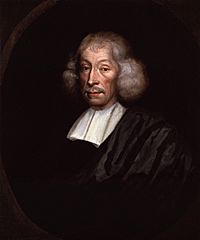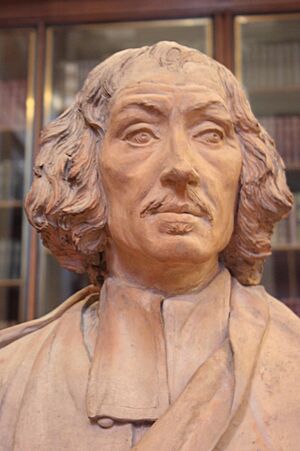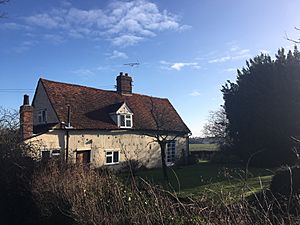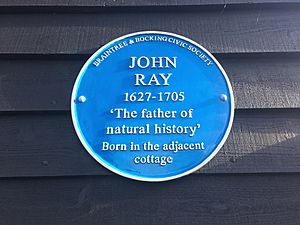John Ray facts for kids
Quick facts for kids
John Ray
|
|
|---|---|

John Ray
|
|
| Born | 29 November 1627 Black Notley, near Braintree, England
|
| Died | 17 January 1705 (aged 77) Black Notley, England
|
| Nationality | English |
| Alma mater | Trinity College, Cambridge St Catharine's College, Cambridge |
| Scientific career | |
| Fields | Botany, Zoology, Natural history, Natural theology |
| Academic advisors | James Duport |
| Author abbrev. (botany) | Ray |

John Ray (born November 29, 1627 – died January 17, 1705) was an English naturalist. He is seen as one of the first "parson-naturalists," meaning he was both a churchman and a scientist studying nature. Until 1670, he spelled his name John Wray. After that, he used 'Ray'.
He wrote important books about botany (plants), zoology (animals), and natural theology (studying God through nature). His way of classifying plants in his book Historia Plantarum was a big step towards modern taxonomy. Taxonomy is the science of naming, defining, and classifying groups of living things.
Ray did not like the old way of classifying species using simple "either/or" choices. Instead, he grouped plants based on how similar or different they looked. He was also one of the first people to define what a species is. He said a species is "a group of similar organisms that come from a common ancestor." Another important idea he had was dividing plants into two main groups: those with two seedling leaves (called dicotyledons) and those with only one (called monocotyledons). This division is still used in science today.
Contents
John Ray's Life
Early Years and Education
John Ray was born in a village called Black Notley in Essex, England. His father was the village blacksmith. John went to Braintree school and then, at age sixteen, he went to Cambridge University. He studied at Trinity College.
At Cambridge, he became a fellow (a senior member of the college) in 1649. He held many jobs at the college, like teaching Greek and mathematics. He also preached in the college chapel. He was known as a great teacher and shared his love for nature with his students. One of his students, Isaac Barrow, later helped his friend Francis Willughby with mathematics. Ray and Willughby would later work together on scientific projects.
Later Life and Family
After leaving Cambridge in 1663, Ray traveled around Britain and Europe. In 1673, he married Margaret Oakley. He moved a few times before settling back in his hometown of Black Notley in 1679.
Even though he had poor health, Ray kept writing books and sending letters to other scientists. He worked with his doctor, Samuel Dale. John Ray lived to be 77 years old and died in Black Notley. He is buried in the churchyard of St Peter and St Paul, where there is a memorial for him. He is remembered as one of the first English parson-naturalists.
John Ray's Work
At Cambridge, John Ray spent a lot of time studying natural history. This was a subject he loved and worked on for most of his life. In 1662, he had to leave his job at Cambridge. This was because he could not agree to a new law called the 'Bartholomew Act'. This law required people to make a special promise. Ray, along with 13 other fellows, chose to resign instead.
Even though he was a nonconformist (someone who did not follow all the rules of the official church), he remained a member of the Church of England.
After leaving Cambridge, he often relied on the support of his former student, Francis Willughby. They became close friends and traveled a lot together. They observed nature and collected many plants, birds, fish, mammals, reptiles, and insects. They planned for Ray to study plants and Willughby to study animals.
In 1663, Ray, Willughby, and two other students went on a long trip through Europe. They returned in 1666, bringing back many collections. Ray had also traveled through Britain several times before this. He later published a book about his travels called Observations topographical, moral, and physiological, made on a Journey through part of the Low Countries, Germany, Italy, and France.
In 1667, Ray became a member of the Royal Society, a famous group for scientists. In 1669, he and Willughby published a paper about how sap moves in trees.
When Willughby died in 1672, Ray took on the job of publishing both Willughby's work and his own. Ray edited Willughby's books on birds (Ornithologia, 1676) and fish. He also worked on his own books about mammals, reptiles, and insects. After Willughby's mother died, Ray lost access to Willughby's collections and notes.
Ray's book Catalogus plantarum Angliae (1670) described plants found in England. This book became a base for later books about English plants. His most important work, Historia generalis plantarum (History of Plants), came out in three volumes between 1686 and 1704.
In the 1690s, Ray published books about religion. The most popular one was The Wisdom of God Manifested in the Works of the Creation (1691). In this book, he wrote about how nature and the universe show God's creation. He looked at how species live and how nature works as a whole.
Ray also gave an early description of dendrochronology. This is the science of dating trees by counting their annual growth rings. He explained how to find the age of an ash tree from its rings.
How John Ray Classified Living Things
John Ray's work on classifying plants changed over time. At first, he followed older ideas, but he later developed his own system. His first plant book, Catalogus plantarum circa Cantabrigiam nascentium (1660), mainly described plants. It was the first book to list plants found in an English county, covering about 630 species.
Ray's Classification System
Ray's system started by dividing plants into two main groups:
- Imperfect or lower plants (like Cryptogams, which do not produce seeds or flowers).
- Perfect or higher plants (called planta perfecta, which are Seed plants).
He then divided the perfect plants by their life forms:
- Trees (arbores)
- Shrubs (frutices)
- Small shrubs (suffrutices)
- Herbaceous plants (herbae, plants with soft stems)
He also grouped them by common features. For example, he divided trees into 8 groups, like Pomiferae (which included apple and pear trees).
In his Historia Plantarum (1685–1703), he showed his system:
- Herbae (Herbaceous plants)
- Imperfectae (Cryptogams)
- Perfectae (Seed plants)
- Monocotyledons (plants with one seed leaf)
- Dicotyledons (plants with two seed leaves)
- Arborae (Trees)
- Monocotyledons
- Dicotyledons
Defining a Species
John Ray was the first person to give a scientific definition of a species. He wrote this in his 1686 book History of Plants:
"The surest way to tell species apart is by the features that continue from one generation to the next through seeds. So, no matter how much individuals or species vary, if they come from the seed of the same plant, those differences are just accidental. They are not enough to make a new species... Animals that are different species also stay different species forever; one species never comes from the seed of another, and vice versa."
John Ray's Publications
John Ray published about 23 works. His science books were usually in Latin, and others were in English. As mentioned, he changed his name spelling from "Wray" to "Ray" around 1670.
Some of his important books include:
- Catalogus plantarum circa Cantabrigiam nascentium (1660): A list of plants found near Cambridge.
- Catalogus plantarum Angliae (1668): A list of plants in England.
- Collection of English proverbs (1670).
- Observations in the Low Countries and Catalogue of plants not native to England (1673): About his travels.
- Willughby's Ornithologia (1676): A book about birds, edited by Ray.
- Methodus plantarum nova (1682): A new way to classify plants.
- Historia plantarum species (1686–1704): His great "History of Plants" in three volumes.
- Synopsis methodica stirpium Britannicarum (1690): A summary of British plants.
- The wisdom of God Manifested in the Works of the Creation (1691): A book about God's design in nature.
- Synopsis methodica avium & piscium (1713, published after he died): A summary of birds and fish.
John Ray's Legacy
John Ray's work was very important for the development of taxonomy. He insisted on careful observation and accurate descriptions. His ideas directly influenced Carl Linnaeus, who created the modern system of classifying living things.
The Ray Society was founded in 1844 and named after John Ray. It is a scientific group that publishes books about natural history, especially about plants and animals in Britain. It is based at the Natural History Museum, London.
There is also a John Ray Society at St Catharine's College, Cambridge, which organizes events for science students.
In 1986, to celebrate 300 years since his Historia Plantarum was published, a "John Ray Gallery" was opened at the Braintree Museum.
The John Ray Initiative (JRI) is a charity formed in 1997. It aims to connect science and Christian beliefs about the environment. John Ray believed that God's wisdom is shown in nature. JRI works to help people appreciate nature, understand environmental problems, and promote a Christian view of caring for the environment.
Images for kids
See also
 In Spanish: John Ray para niños
In Spanish: John Ray para niños















